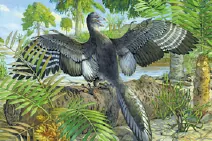
Groundbreaking Discoveries: How Archaeopteryx is Shaping Our Understanding of the Dinosaur-Bird Transition
2025-05-20
Author: Wei Ling
Revolutionary Insights from Prehistoric Fossils
A collaborative research effort between scientists from China and the United States has uncorked extraordinary revelations about the evolutionary leap from dinosaurs to birds, centered around a stunningly preserved specimen of Archaeopteryx.
Unlocking the Secrets of Archaeopteryx
Archaeopteryx, famously dubbed the most primitive bird of the Late Jurassic period—dating back a staggering 150 million years—represents a vital missing link in paleontological studies, showcasing characteristics of both ancient avian and non-avian dinosaurs.
The most recent fossil discovery, recently unearthed in the limestone deposits of Solnhofen, Germany, marks a milestone as the smallest and most intact specimen of its kind. Collected by the Field Museum in Chicago in 2022, this pigeon-sized marvel is an archaeological treasure.
A Breakthrough in 3D Evolutionary Reconstruction
According to lead researcher Hu Han, an expert from the Institute of Vertebrate Paleontology and Paleoanthropology, this exceptional specimen—remarkably preserved with just one digit missing—has set the stage for the first-ever complete 3D reconstruction of Archaeopteryx, especially focusing on its skull.
"This achievement is a game changer," Hu exclaimed. "It unveils unknown anatomical features and establishes a formidable 3D model for future research endeavors."
A New Look at Dinosaurian Habits
Utilizing high-resolution CT scans and cutting-edge 3D reconstruction techniques, researchers have discovered an almost entirely intact skull that provides critical insights into the creature's evolution—from the rigid skulls of nonavian theropods to the more dynamic skull structures of contemporary birds.
Moreover, remnants of soft tissues, notably toe pads resembling those of present-day ground birds, hint at a versatile lifestyle for Archaeopteryx—suggesting it spent time both in the trees and on the ground, challenging previous assumptions about its behavior.
Feathers: The Key to Flight?
The study also illuminated new aspects of Archaeopteryx's wing structure, revealing the presence of tertials—specialized flight feathers crucial for optimizing wing shape and flight efficiency. Hu noted, "This find offers groundbreaking evidence of how anatomical features were adapted in response to evolutionary needs."
Continuing the Quest for Knowledge
Since the first Archaeopteryx fossil was discovered in 1861, soon after Darwin's pivotal theory of evolution was introduced, it has stood as a cornerstone for supporting evolutionary theory. Building on this recent 3D reconstruction, researchers plan to dive deeper into the biomechanics of the skull and the aerodynamics of its wings, further unraveling the mystery of how dinosaurs evolved into flighted birds.
With every new discovery, we move closer to understanding the magnificent transition from prehistoric giants to the diverse avian species we see today.




 Brasil (PT)
Brasil (PT)
 Canada (EN)
Canada (EN)
 Chile (ES)
Chile (ES)
 Česko (CS)
Česko (CS)
 대한민국 (KO)
대한민국 (KO)
 España (ES)
España (ES)
 France (FR)
France (FR)
 Hong Kong (EN)
Hong Kong (EN)
 Italia (IT)
Italia (IT)
 日本 (JA)
日本 (JA)
 Magyarország (HU)
Magyarország (HU)
 Norge (NO)
Norge (NO)
 Polska (PL)
Polska (PL)
 Schweiz (DE)
Schweiz (DE)
 Singapore (EN)
Singapore (EN)
 Sverige (SV)
Sverige (SV)
 Suomi (FI)
Suomi (FI)
 Türkiye (TR)
Türkiye (TR)
 الإمارات العربية المتحدة (AR)
الإمارات العربية المتحدة (AR)